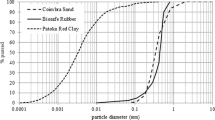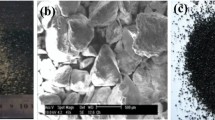Abstract
Scrap tire rubber is light mass and has heat-insulation properties. It can be mixed with building materials to form a new type of sustainable composite. Thermal conductivity is an important parameter affecting the thermal properties of building materials. Herein, the thermal conductivity of scrap rubber–sand mixtures was measured using a thermal probe; the effects of rubber content, moisture content, and dry density on the thermal conductivity of the mixture were studied, and a theoretical calculation model for the thermal conductivity of scrap rubber–sand mixtures was established. The results show that the thermal conductivity of scrap rubber–sand mixtures decreases with increases in the rubber content and reductions in the dry density. The thermal conductivity of the mixture increases with increases in moisture content. The established theoretical calculation model can accurately calculate the thermal conductivity of scrap rubber–sand mixtures, with R2 = 0.88, MAE = 0.044 (Wm−1 K−1), and RMSE = 0.071 (Wm−1 K−1). The prediction accuracy of the theoretical model is obviously superior to that of the traditional empirical model. It provides an accurate method for predicting the thermal conductivity of scrap rubber–sand mixtures.











Similar content being viewed by others
References
Yadav JS, Tiwari SK. Effect of waste rubber fibres on the geotechnical properties of clay stabilized with cement. Appl Clay Sci. 2017;149:97–110.
Arulrajah A, Mohammadinia A, Maghool F, Horpibulsuk S. Tyre derived aggregates and waste rock blends: resilient moduli characteristics. Constr Build Mater. 2019;201:207–17.
Nezhad MG, Tabarsa A, Latifi N. Effect of natural and synthetic fibers reinforcement on California bearing ratio and tensile strength of clay. J Rock Mech Geotech Eng. 2021;13:626–42.
Neaz Sheikh M, Mashiri MS, Vinod JS, Tsang H-H. Shear and compressibility behavior of sand–tire crumb mixtures. J Mater Civ Eng. 2013;25:1366–74.
Tafreshi SNM, Mehrjardi GhT, Dawson AR. Buried pipes in rubber–soil backfilled trenches under cyclic loading. J Geotech Geoenviron Eng. 2012;138:1346–56.
Mounanga P, Gbongbon W, Poullain P, Turcry P. Proportioning and characterization of lightweight concrete mixtures made with rigid polyurethane foam wastes. Cement Concr Compos. 2008;30:806–14.
Hennebert P, Lambert S, Fouillen F, Charrasse B. Assessing the environmental impact of shredded tires as embankment fill material. Can Geotech J. 2014;51:469–78.
Zornberg JG, Cabral AR, Viratjandr C. Behaviour of tire shred sand mixtures. Can Geotech J. 2004;41:227–41.
Chaney R, Demars K, Feng Z-Y, Sutter K. Dynamic properties of granulated rubber/sand mixtures. Geotech Test J. 2000;23:338.
Anastasiadis A, Senetakis K, Pitilakis K, Gargala C, Karakasi I, Edil T, et al. Dynamic behavior of sand/rubber mixtures. Part I: effect of rubber content and duration of confinement on small-strain shear modulus and damping ratio. J ASTM Int. 2012;9:103680.
Hazarika H, Kohama E, Sugano T. Underwater shake table tests on waterfront structures protected with tire chips cushion. J Geotech Geoenviron Eng. 2008;134:1706–19.
Orakoglu Firat ME, Atila O. Investigation of the thermal conductivity of soil subjected to freeze–thaw cycles using the artificial neural network model. J Therm Anal Calorim. 2022;147:8077–93.
Wang C, Cai G, Wu M, Zhao Z. Prediction of soil thermal conductivity based on multivariate probability distribution models. Int Commun Heat Mass Transfer. 2022;138: 106355.
Wang W, Chen C, Xu W, Li C, Li Y-Z. Experimental research on heat transfer characteristics and temperature rise law of in situ thermal remediation of soil. J Therm Anal Calorim. 2022;147:3365–78.
Liang B, Chen M, Guan J. Assessment on the thermal and moisture migration of sand-based materials coupled with kaolin additive. J Therm Anal Calorim. 2022;147:10163–76.
Li CY, Liu HB, Wei HB. An experimental study on engineering properties of rubber particles-improved fly ash soil. AMM. 2011;71–78:3401–6.
Lee JK, Shang JQ. Thermal properties of mine tailings and tire crumbs mixtures. Constr Build Mater. 2013;48:636–46.
Lee JK, Shang JQ, Jeong S. Thermal conductivity of compacted fill with mine tailings and recycled tire particles. Soils Found. 2015;55:1454–65.
Liu L, Cai G, Liu X. Investigation of thermal conductivity and prediction model of recycled tire rubber–sand mixtures as lightweight backfill. Constr Build Mater. 2020;248: 118657.
Xiao Y, Nan B, McCartney JS. Thermal conductivity of sand–tire shred mixtures. J Geotech Geoenviron Eng. 2019;145:06019012.
Zhang T, Cai G, Liu S, Duan W. Laboratory observation of engineering properties and deformation mechanisms of cemented rubber–sand mixtures. Constr Build Mater. 2016;120:514–23.
Selig E, Ladd R. Preparing test specimens using undercompaction. Geotech Test J. 1978;1:16.
Zhang T, Cai G, Liu S, Puppala AJ. Investigation on thermal characteristics and prediction models of soils. Int J Heat Mass Transf. 2017;106:1074–86.
Cai G, Zhang T, Puppala AJ, Liu S. Thermal characterization and prediction model of typical soils in Nanjing area of China. Eng Geol. 2015;191:23–30.
Zhang N, Wang Z. Review of soil thermal conductivity and predictive models. Int J Therm Sci. 2017;117:172–83.
Horai K. Thermal conductivity of rock-forming minerals. J Geophys Res. 1971;76:1278–308.
Stephan K, Laesecke A. The Thermal Conductivity of Fluid Air. J Phys Chem Ref Data. 1985;14:227–34.
Salomone LA, Kovacs WD. Thermal resistivity of soils. J Geotech Eng. 1984;110:375–89.
Bi J, Zhang M, Lai Y, Pei W, Lu J, You Z, et al. A generalized model for calculating the thermal conductivity of freezing soils based on soil components and frost heave. Int J Heat Mass Transf. 2020;150: 119166.
Bi J, Zhang M, Chen W, Lu J, Lai Y. A new model to determine the thermal conductivity of fine-grained soils. Int J Heat Mass Transf. 2018;123:407–17.
Tong F, Jing L, Zimmerman RW. An effective thermal conductivity model of geological porous media for coupled thermo-hydro-mechanical systems with multiphase flow. Int J Rock Mech Min Sci. 2009;46:1358–69.
Kannuluik W, Carman E. The temperature dependence of the thermal conductivity of air. Aust J Chem. 1951;4:305.
Tang A-M, Cui Y-J, Le T-T. A study on the thermal conductivity of compacted bentonites. Appl Clay Sci. 2008;41:181–9.
Chen Y, Zhou S, Hu R, Zhou C. Estimating effective thermal conductivity of unsaturated bentonites with consideration of coupled thermo-hydro-mechanical effects. Int J Heat Mass Transf. 2014;72:656–67.
Wang C, Cai G, Liu X, Wu M. Prediction of soil thermal conductivity based on Intelligent computing model. Heat Mass Transfer. 2022;58:1695–708.
Gokceoglu C. A fuzzy triangular chart to predict the uniaxial compressive strength of the Ankara agglomerates from their petrographic composition. Eng Geol. 2002;66:39–51.
Yukselen Y, Erzin Y. Artificial neural networks approach for zeta potential of Montmorillonite in the presence of different cations. Environ Geol. 2008;54:1059–66.
Kersten M. Laboratory research for the determination of the thermal properties of soil. ACFEL Tech Rep. 1949;23.
Gangadhara Rao M, Singh DN. A generalized relationship to estimate thermal resistivity of soils. Can Geotech J. 1999;36:767–73.
Acknowledgements
This paper was supported by National Science Fund for Distinguished Young Scholars (Grant No. 42225206), the National Natural Science Foundation of China (Grant No. 41877231, No. 42072299), and Project of Jiangsu Province Transportation Engineering Construction Bureau (7921004042B).
Author information
Authors and Affiliations
Contributions
CW: Conceptualization; Methodology; Investigation; Formal analysis; Data Curation; Visualization; Writing. MW: Conceptualization; Visualization; Writing; Supervision. GC: Formal Analysis; Investigation; Data Curation; Visualization; Writing. JC: Conceptualization; Visualization; Writing. ZZ: Investigation; Visualization; Writing.
Corresponding author
Additional information
Publisher's Note
Springer Nature remains neutral with regard to jurisdictional claims in published maps and institutional affiliations.
Rights and permissions
Springer Nature or its licensor (e.g. a society or other partner) holds exclusive rights to this article under a publishing agreement with the author(s) or other rightsholder(s); author self-archiving of the accepted manuscript version of this article is solely governed by the terms of such publishing agreement and applicable law.
About this article
Cite this article
Wang, C., Wu, M., Cai, G. et al. Theoretical calculation model for the thermal conductivity of scrap tire rubber–sand mixtures based on soil components. J Therm Anal Calorim 148, 11041–11051 (2023). https://doi.org/10.1007/s10973-023-12329-4
Received:
Accepted:
Published:
Issue Date:
DOI: https://doi.org/10.1007/s10973-023-12329-4




